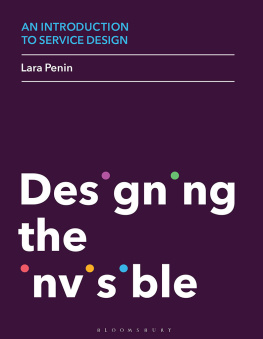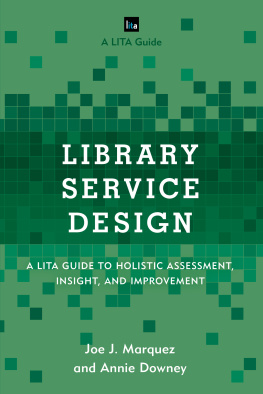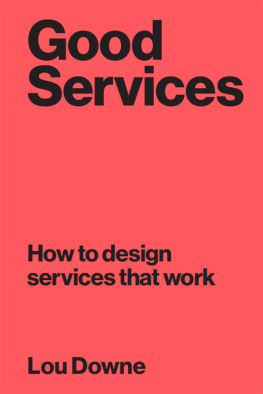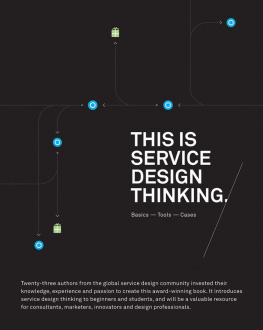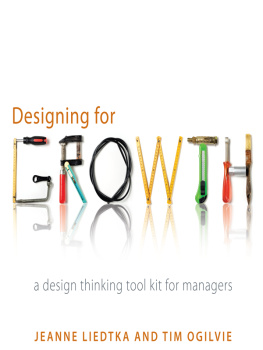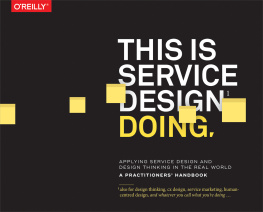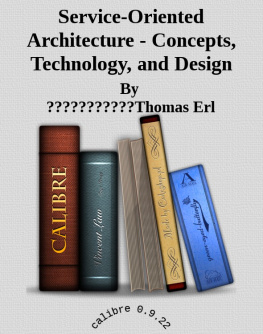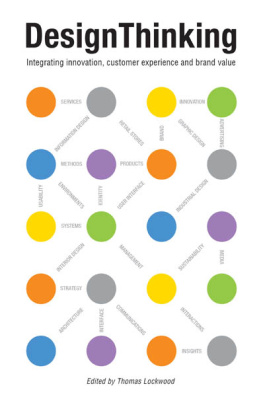
Table of Contents
Part I
Understanding Services
Main concepts, critical aspects and implications of designing services, discussed by experts
Defining services
The service economy
Digital services
Services for public interest
The politics of service design
Designing for services
Part II
The Service Design Process
The service design process, methods and tools explained through outstanding projects and discussed by the designers behind them
Starting the service design process


Research and analysis







Generating service design concepts




Prototyping, testing, iterating



Implementation and evaluation




Service design core capabilities
Foreword Clive Dilnot
The play between the tangible and the intangible, the visible and the invisible, has always been integral to design. It was, after all, its raison detre. Designers have only ever been employed because the refinements they add to the simple fact of a thing contribute to its experience and hence to its desirability. But while experiences are propelled by the material qualities of the thing, it takes place In mind. It might be better to say then that the tangible induces the intangible.
Service design is, in a way, no more, and no less, than thisbut in reverse. In designing a service, the aim is often all but intangible: the felt quality of the experience offered. Yet the paradox of this intangibility is that this experience is very largely delivered through material means (even if the material here might be the actions of, or encounters with, other human beings). This has always been the case. Think of religious rituals. Services of worship are, by definition, services. Their choreography is as carefully plotted as the configuration of a building. Indeed, in this case, the latter is often servant to the former. So a service is no less an artifact than a physical thing. The difference is that here the artifact is the choreographed ensemble of places, things, communications, scripted encounters and so onin a word the assemblagethat delivers the service and which the subject encounters as a set of experiences (since services unfold always over time). But there is no evasion of design. Even in those religions stressing the least ritualistic emphasis to the communion and connection with God, the quality of the spaces in which these meetings take placethink of the washed plain light of a Quaker or Shaker meeting houseis as significant and no less material, no less designed, than the Baroque interior of St. Peters. Despite what architects sometimes like to pretend, no architecture is merely physical. Site is always really situation. Situation means the encounter of a person and a context: a context that usually contains other persons and has its basis in a material human need. Situations are fundamental, they are in a sense, even prior to artifacts. Not for nothing did even that most technological of design theorists (Herbert Simon) nonetheless famously insist, back as early as 1968, that to design is to devise of actions to change existing situations into preferred ones.
It is important to stress the ethics of the situationand therefore the ethics of service design. which is nothing more than and nothing less than!) the design of situationsbecause the same monetarizing impulse which makes the seizing of intimate human moments one branch of how the contemporary economy keeps itself afloat also seizes service design, both in the private and in the public sector. The operationalizing of service design, often under a jargon that is as inflated and barbaric as the claims of the economy itself, distorts what is really at stake here, which is the experience of being human. Too easily commoditized, Badious double rule is too easily forgotten, too easily disposed of when profit is put in question.
Yet, outside of the profit motive, the reason why anyone takes up the mantle of service design is surely in fact to help make manifest, in concrete human situations, Badious ethic. Service design in this sense is an ethical act. It is using the capacities of design to establish resonance between things and persons for human ends. Technocratic and econometric formulations of service design tend to obscure this more fundamental truth. In fact, branding and marketing have almost nothing to do with service designand, as we know, are often counterproductive, contributing to the wider devaluing of experience in the contemporary economy. Real service design has its ethos, by contrast, in how, out of sometimes the most constrained and difficult situationsthe conditions and character of the delivery of cancer treatments, for examplewe can create moments that can relieve, even in small ways, the tensions of the experience, and can do so through design. Through design means here undertaking that extraordinary act that all design achieves when it translates a perception about a human condition or encounter into an artifact that helps relieve or enhance it. That is why service design is necessarily ethical. It deals with how subjects are enabled to act in the world.
Now all this might seem a long way from what is essentially a working handbook for learning about, and then for doing, service design. But it is not, for this is the essential (human) underpinning to service design. I will note in particular ). The literacy of designing in this field of encounters and situations has to come into play; the developments of professional capacities to translate perceptions into forms, experiences, ensembles, and arrangements; choreographic and choreographed structures are not less; indeed, they are often
Next page
